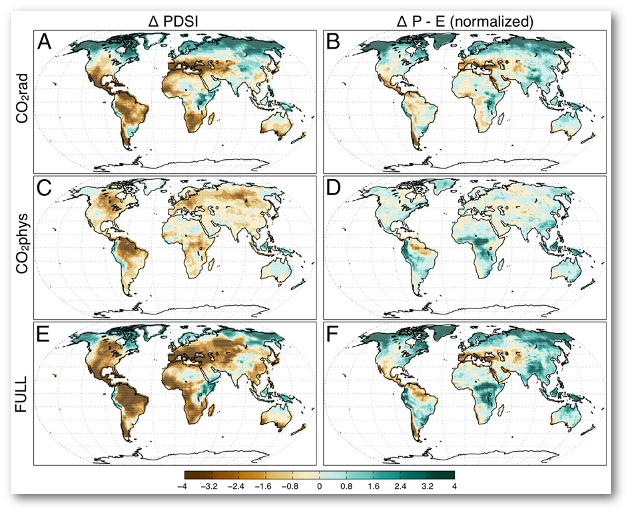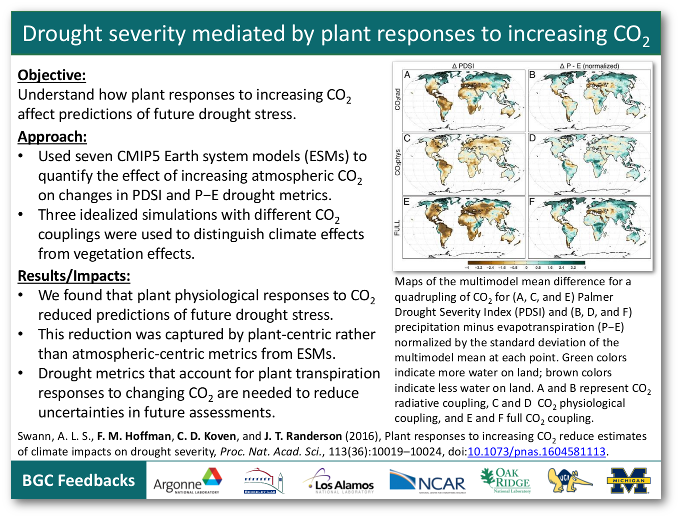Research Highlights
Drought severity mediated by plant responses to increasing CO2
September 6, 2016
The Science
Rising atmospheric CO2 will make Earth warmer, and many studies have inferred that this warming will cause droughts to become more widespread and severe. However, rising atmospheric CO2 also modifies stomatal conductance and plant water use, processes that are often are overlooked in impact analysis. We found that plant physiological responses to CO2 reduce predictions of future drought stress, and that this reduction is captured by using plant-centric rather than atmosphere-centric metrics from Earth system models (ESMs).
The Impact
The atmosphere-centric Palmer Drought Severity Index predicts future increases in drought stress for more than 70% of global land area. This area drops to 37% with the use of precipitation minus evapotranspiration (P−E), a measure that represents the water flux available to downstream ecosystems and humans. The two metrics yield consistent estimates of increasing stress in regions where precipitation decreases are more robust (southern North America, northeastern South America, and southern Europe). The metrics produce diverging estimates elsewhere, with P−E predicting decreasing stress across temperate Asia and central Africa.
Summary
The differing sensitivity of drought metrics to radiative and physiological aspects of increasing CO2 partly explains the divergent estimates of future drought reported in recent studies. Further, use of ESM output in offline models may double-count plant feedbacks on relative humidity and other surface variables, leading to overestimates of future stress. The use of drought metrics that account for the response of plant transpiration to changing CO2, including direct use of P−E and soil moisture from ESMs, is needed to reduce uncertainties in future assessment.
Objective
Understand how plant responses to increasing CO2 affect predictions of future drought stress.
Approach
- Used seven CMIP5 Earth system models (ESMs) to quantify the effect of increasing atmospheric CO2 on changes in PDSI and P−E drought metrics.
- Three idealized simulations with different CO2 couplings were used to distinguish climate effects from vegetation effects.
 |
Maps of the multimodel mean difference for a quadrupling of CO2 for (A, C, and E) Palmer Drought Severity Index (PDSI) and (B, D, and F) precipitation minus evapotranspiration (P−E) normalized by the standard deviation of the multimodel mean at each point. Green colors indicate more water on land; brown colors indicate less water on land. A and B represent CO2 radiative coupling, C and D CO2 physiological coupling, and E and F full CO2 coupling. |
Results/Impacts
- We found that plant physiological responses to CO2 reduced predictions of future drought stress.
- This reduction was captured by plant-centric rather than atmospheric-centric metrics from ESMs.
- Drought metrics that account for plant transpiration responses to changing CO2 are needed to reduce uncertainties in future assessments.
Swann, Abigail L. S., Forrest M. Hoffman, Charles D. Koven, and James T. Randerson. September 6, 2016. “Plant Responses to Increasing CO2 Reduce Estimates of Climate Impacts on Drought Severity.” Proc. Nat. Acad. Sci., 113(36):10019–10024. doi:10.1073/pnas.1604581113.
